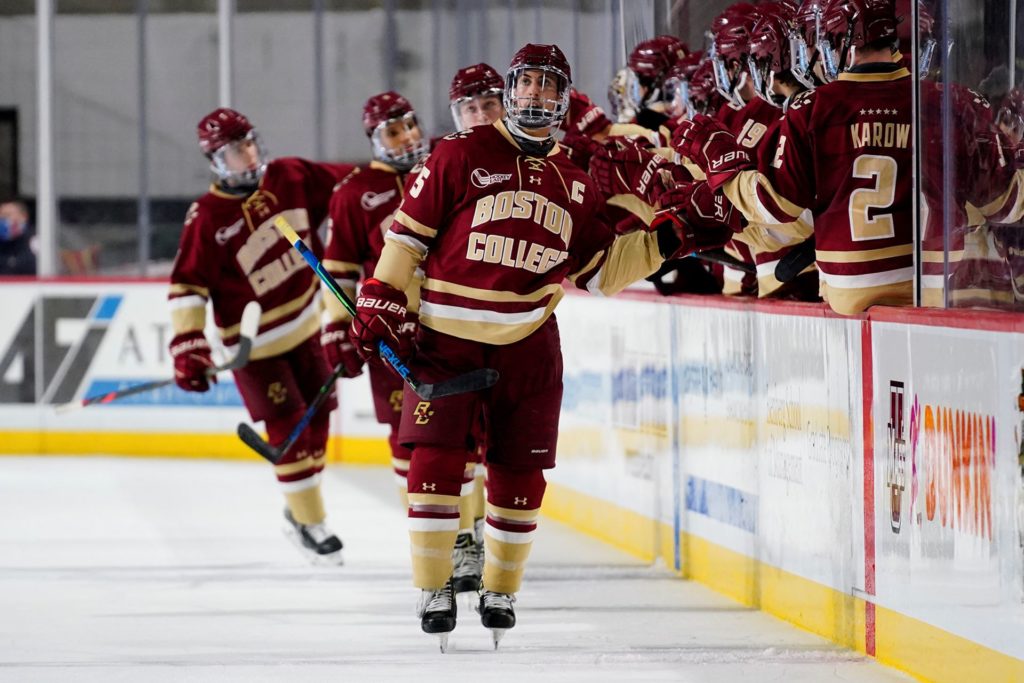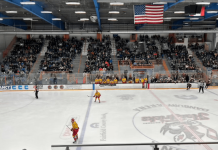
Each week during the season, we look at the big events and big games around Division I men’s college hockey in Tuesday Morning Quarterback.
Paula: Jimmy, it seems ironic that there is so much hockey to talk about this week given how many teams haven’t begun playing yet, how many games have been postponed and the number of programs that aren’t playing at all.
We have Boston College’s strong showing against Massachusetts to start the Hockey East season. As we have often said in the past, it’s impossible to extrapolate based on such little early-season data, but seven different Eagles scored 10 goals in that series, and that may speak to BC’s depth. The voters are pretty high on Boston College early in the season. I know I voted them No. 1 this week.
Then there’s Arizona State’s sweep of Wisconsin. The Badgers looked like a team on a mission in their first four games of the season, all conference games. After losing 3-1 Saturday – ASU’s first win of the season – the Badgers allowed eight goals in Sunday’s loss. Of course, the Badgers were without four players, reportedly because of something COVID-related, but that takes nothing away from the improvement the Sun Devils showed.
Sticking to the Big Ten, it looks like Notre Dame used some time away from the ice wisely. In their series against Wisconsin (Nov. 13-14), the Irish dropped two and scored three total goals. Against Michigan and on the road this past weekend, they swept a very good Michigan team. I watched those games. It was more than the sophomore Ryan Bischell’s .951 save percentage in his first two games of the year.
And now we’re all eagerly anticipating the start of the NCHC bubble.
So much to process, and all through the lens of the COVID-19 pandemic. What are your early thoughts?
Jim: Well, you’ve certainly highlighted some of the key takeaways from the weekend. But I think I want to look ahead to something you mentioned: the NCHC bubble.
First off, this is a fantastic experiment carried out by this league and something, in a way, I wish more leagues considered. I really detest using the term “win-win,” but this is one case where the term is appropriate.
The league and its eight members have the ability to play a professional-like schedule over a three-week period and, in that time, allow most of the teams to play 10 conference games. The city of Omaha benefits at a time when cities are hurting. Hospitality businesses like hotels and restaurants will receive a quick influx of volume. And by placing the student-athletes and their staffs in this pod, with extensive testing on a medical campus with trained professionals, it feels like this will be one of the safest environments at a time when COVID cases seem to be surging.
I wish other leagues took this approach, maybe not just to play league games, but non-league as well.
We saw this past week where college basketball used bubble-like experiences (one that comes to mind is Mohegan Sun in Connecticut which hosted 12 teams and played a plethora of non-conference games) to help give teams an opportunity to face non-conference opponents.
To me, that’s a brilliant solution to a problem, don’t you think?
Paula: I do agree that it’s the best possible scenario for teams and leagues for whom this is a possibility. Without creating the kind of hermetically sealed bubbles that the NHL, the NBA and the WBNA created – and to great success – the NCHC’s pod will provide as much protection for all involved, especially those who are considered Tier 1 participants, which includes everyone essential to games, like the student-athletes, coaches, staff, officials and many medical personnel.
It’s also important to note that people who are Tier 3 – like media – won’t have any in-person interactions whatsoever with the Tier 1 folks, so that those involved in the games themselves are as protected as they can be.
I know that everyone will respect the NCHC’s protocols to mitigate risk – and I don’t want to debate whether or not we should be doing sports at all right now, because I’ve made my very mixed feelings about that known to the world – and I am all for any economic boost that the Omaha area may see from this.
The pluses you list are all positives, Jimmy. I don’t know, though, that this doesn’t further expose the gap between the haves and have-nots of college hockey. This certainly feels like something the Big Ten could have done, but I suspect that we’ll see similar results between the NCHC and B1G Hockey regarding COVID exposure and infections because of the Big Ten’s own rigorous protocols, even without the kind of pod that the NCHC set up.
How feasible would this have been, though, for the WCHA or Atlantic Hockey? I keep going back to what Bob Motzko said about how the teams – and by extension, the leagues – who can handle the pandemic best will prevail this season, and I wonder if some leagues lack the resources to do what the NCHC has done.
Jim: I’ve made a point of big-budget programs having the best chance to succeed in the past. And I stand by the way the Power 5 teams have much deeper resources to test, one of the most critical parts to keep players and staffs safe.
But then I look at the NCHC. Yes, these are eight schools that have made it clear that hockey is a major athletic priority at their institution. But none of these are Power 5 schools and a number of them aren’t even Division I in any sports besides hockey.
In my opinion, what it comes down to is a decision of how to spend your athletics budget. And I don’t think we, let alone anyone, are in a position to criticize or question how athletic departments are spending right now. Some sports take larger priority like basketball and football.
It will be interesting to see if any conferences change courses. Will anyone halt play between now and the end of the year? Will any conferences look to play at least a small portion of their season inside a bubble (though it seems a little late to begin that process, even for say the final month of the regular season)? And I guess, should we get there, will conferences and maybe even the NCAA consider using a bubble structure for postseason tournaments?
Paula: I am certainly not criticizing how athletic departments are spending their money and I commend the NCHC and its member teams for going to these lengths to protect everyone involved.
Your questions about how things will progress are intriguing. I have mused with a few people about how this season will progress. It seems likely that any number of programs will experience delays and perhaps whole leagues will as well, and it is probable that such delays will not necessarily be concurrent, that these things will be impossible to predict and scattered. It is also likely that online classes will be widespread during the second half of the season, giving schools and leagues flexibility to juggle schedules and prolong the overall D-I hockey schedule if necessary. I wouldn’t be surprised to see the season extended beyond April to fit in enough play among all the remaining participants to create a meaningful national championship.
And, yes, I do think the NCAA should consider a type of bubble or pod structure for postseason play, including conference playoffs.
Do you think an extended season is possible? Even before that, do you think that conferences may bubble up for stretches to make this season work?
Jim: I do think that bubbles will be created for the conference tournaments and possibly even the entire NCAA tournament. If that is the case, I think there is an ability to extend the season knowing that there isn’t a Frozen Four deadline looming. Will all of this take maneuvering? Yes, but that seems to be the theme of this season.
One last topic before we sign off – USA Hockey announced its preliminary World Junior Camp roster with 21 collegiate players heading to the final evaluation camp. More notably, though, is that five players on the roster emanating from California, the most of any state other than the six players from Massachusetts. A notable fact showing how hockey continues to expand throughout this country. Now – just as we continue to cross our fingers on in college hockey – let’s hope the tournament is played.

